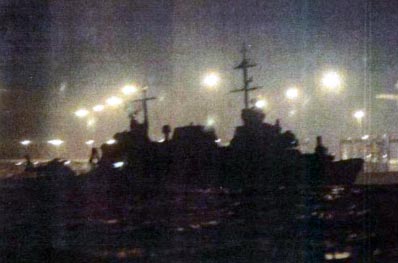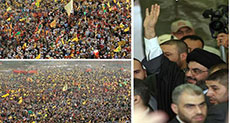
Reminiscence: Demolition of “Sa’ar 5” Corvette Forces “Israeli” Navy Out of War

By Maysaa Shedid
"...We are absolutely ready for the confrontation, no matter how serious it gets. So the enemy must expect surprises if it decides to confront us," said Hizbullah Secretary General His Eminence Sayyed Hassan Nasrallah in a press conference following "Operation Truthful Pledge" (Arabic; "al-Waad as-Saddeq").
Barely had two days passed when time for the first surprise came: Around 8:45 p.m. on Friday, July 14, 2006, the Islamic-Resistance leader delivered a voice message via "al-Manar Television", confirming:
"The surprises I've promised you shall now begin. Right now, in the middle of the sea facing Beirut, you can see the "Israeli" corvette that assailed civilians and our infrastructure and houses afire. It is going to sink along with tens of Zionist "Israeli" soldiers."
These words sounded enough for the Lebanese people, the whole world, and even the "Israeli" enemy, for it was Hizbullah Secretary General who said them.
The scene of the burning warship, however, had its very own weight; the Lebanese people, especially the ones displaced by the Zionist shelling, were brought back to their spirits.
 Still, the fact that the warship was demolished made the greatest impact on the enemy. Overwhelmed that "Hanit" was targeted, the enemy command had to acknowledge it had had no news on Hizbullah's possession of the missile striking the warship and showing capacity to overcome the warship's positive and negative defenses.
Still, the fact that the warship was demolished made the greatest impact on the enemy. Overwhelmed that "Hanit" was targeted, the enemy command had to acknowledge it had had no news on Hizbullah's possession of the missile striking the warship and showing capacity to overcome the warship's positive and negative defenses.
The warship's demolition as well represented a significant turning point for Hizbullah's media war, which did make the "Israeli" public opinion lose confidence in the "Israeli" command.
According to the data stated then, the Islamic Resistance struck the warship with a missile technologically developed in China.
Having been headed straight to the target, the radar-guided missile hit the helipad as well as the soldiers' bedrooms on the floors below. Apparently, the missile strike deactivated the warship's ability of movement and direction. Eventually, the "Israeli" fleet needed more than 20 hours to tug "Hanit" away from the Lebanese seashore.
Military Interpretation on "Hanit's" Demolition
The military expert retired Brigadier General Dr. Amin Hoteit considered the impact of the warship destruction depended on the influence of the missile on the battle field.
In fact, "Sa'ar 5" was supposed to carry out two assignments: monitoring and besieging the Lebanese seashore, in addition to backing the other "Israeli" forces shelling the residential areas in Beirut and Beirut Southern Suburb.
Believing that no armament was sited along the seashore, the "Israeli" enemy approached points very close to the armament sites, to monitor the shore more accurately and keep it within a fiercer fire range, General Hoteit pointed out.
Hereupon, General Hoteit summed up the direct as well as the indirect outcomes of the warship's demolition: The warship was forced out of the battle, breaking through the besiegement. Even calling for a relief warship needed time, through which the besiegement could be broken.
"Hanit's" demolition removed the geographic expanse of Beirut and Beirut Southern Suburb from the range of monitoring and barrage.
As to the indirect impacts, Hoteit said, "The uncovering of land-to-sea missiles forced any substitute warship as well as the other war boats to stay away from the effective range of missiles. That is, the detection of a missile imposed precautions, and that meant less monitoring and fire, so it was a great military defeat." General Hoteit now added, "The corvette's demolition was quite overwhelming; the critical situation itself downgraded the level of the "Israeli" navy's military performance."
Furthermore, Hoteit said, ""Hanit's" destruction represented an extremely significant tactic, as it did affect the monitoring system and the barrage. This pushed the "Israeli" enemy to remedy this system and rather depend on other systems so as to fill the gap "Hanit's" demolition had already created.
Zionist Entity's Navy Falls after "Hanit's" Demolition
The coup the Islamic Resistance delivered to the corvette still overwhelms the "Israeli" military.
Analysts and observers now wonder whether the "Israeli" military did the right thing spending tens of millions of dollars to buy new warships after Hizbullah demolished "Sa'ar 5", the topmost navy corvette.
In fact, the warship's demolition represented one of the greatest "Israeli" failures during "the July War" (called "the Second Lebanon War" by "Israel"). "The military and intelligence system was unbalanced, and the discipline failed," concluded the subsequent investigation made, "hereupon, a piece of the alarm system on board of the corvette was deactivated. The piece was actually supposed to diagnose any surrounding threats and locate the enemy's missile radars. It was the electronic officer's fault as he did not notify the skipper of the defect. Having none of its defensive systems activated, "Hanit" remained exposed to threats."
Eventually, the investigation resulted in "slaps on the wrists" of five officers in charge. Sources of the navy considered that "in spite of the investigation's serious outcomes, the penalties were very slight. The investigation did reveal it wasn't a mere theoretical and operative failure of the navy."
Expert on "Israeli" affairs Ali Haidar sees that the issue of "slapping wrists" was only a public façade; whereas the secret part of the investigation included a search for the means to confront Hizbullah's targeting of the "Israeli" navy. In reality, that experience proved the Islamic Resistance endangered the entire "Israeli" navy rather than only "Hanit", especially when the Resistance declared it had demolished another warship, the fact unacknowledged by the enemy; otherwise, that would have represented an obvious acknowledgement the navy was demolished." In this regard, an "Israeli" commentator speaking via "Israeli" television said, "Striking this warship in particular, Hizbullah demolished the entire "Israeli" navy."
Haidar added, "The Resistance, making the initiative as to striking the navy, surprised "Israel's" intelligence and operative units." Haidar refuted the enemy's claim that "the warship was demolished since the anti-missile system was inactivated. That is, after the warship was hit, all "Israeli" vessels moved away from the Lebanese seashore. This confirmed that "Israel" wasn't aware the Resistance could target the "Israeli" navy with this kind of arms."
"Hanit's" demolition introduced the Resistance's surprises: Haifa and a wider range were bombarded, a helicopter was shot, and heroic confrontations occurred in the battle field; afterwards came the massive demolition of the Merkava tanks... Day after day, the surprises brought about new equations, whereby the investigations regarding the failures of "the July War" (called "the Second Lebanon War" by "Israel") eventually revealed that the enemy military faced more than mere logistic obstacles. The military completely failed to understand the Lebanese reality and the Resistance's power and ability to confront the "Israeli" war craft.
"Hanit": "Israeli" Topmost Missile-Launching Warship
"Hanit" was the topmost "Israeli" missile-launching warship, and its production cost reached hundreds of millions of dollars. In 1995, a US firm built "Hanit" of the "Sa'ar 5" corvette and handed it to the "Israeli" navy. "Hanit" was one of the 3 warships "Israel" possessed. Besides being quite expensive, "Hanit" enjoyed high qualities of the ordnance. Not only did "Hanit" have main arms on board, but also it had the most recent warring techniques. Therefore, it was classified as "Israel's" topmost warship and one of the best warships in the world.
"Hanit" could carry a helicopter on board. It was able to confront ground forces, and it was provided with anti-aircraft systems and anti-submarines missiles. The warship was also highly capable of staying long in waters, and it was provided with the most expensive and advanced technological and armament systems, the mere citing of some of which by the "Israeli" media "Israel" even censored.
In reality, the apparent armament systems offered the warship advancements unprecedented in all maritime battles.
That is, the warship was provided with "Burberry Masker System", which enabled the warship to operate its engines without any noise or vibration; therefore the detection of the warship became hard. The warship was as well provided with a system for cooling its emitted gases and materials for absorbing radar waves.
"Hanit" could stay for 20 days in the waters without reaching ports. Its speed was 33 knots when activated by gas turbines and 20 knots when activated by diesel engines. Its sailing range reached 3500 miles as an average speed of 17 knots. On board, "Hanit" carried a 227 kg warhead, in addition to 8 navy US Harpoon missiles, which radars could direct to far distances.
Besides, "Hanit" carried anti-aircraft missiles that could also be directed against missiles, in addition to "Israeli" "Barak" missiles, which could demolish attacking missiles and deal with different aerial targets as planes and little drones.
"Barak" missile could be vertically launched; thus, it could deal with any target anywhere along a circumference of 360˚. Yet, what actually characterized the warship more than anything else was its ability to make use of electronic war through negative-defense arsenals (of perturbation and devastation) and positive-defense systems (of confrontation and defense). The ship crew normally included 64 members, including 16 officers. Two other crews of the air forces and intelligence served on board of the ship, too.
Source: Al-Intiqad, translated and edited by moqawama.org
"...We are absolutely ready for the confrontation, no matter how serious it gets. So the enemy must expect surprises if it decides to confront us," said Hizbullah Secretary General His Eminence Sayyed Hassan Nasrallah in a press conference following "Operation Truthful Pledge" (Arabic; "al-Waad as-Saddeq").
Barely had two days passed when time for the first surprise came: Around 8:45 p.m. on Friday, July 14, 2006, the Islamic-Resistance leader delivered a voice message via "al-Manar Television", confirming:
"The surprises I've promised you shall now begin. Right now, in the middle of the sea facing Beirut, you can see the "Israeli" corvette that assailed civilians and our infrastructure and houses afire. It is going to sink along with tens of Zionist "Israeli" soldiers."
These words sounded enough for the Lebanese people, the whole world, and even the "Israeli" enemy, for it was Hizbullah Secretary General who said them.
The scene of the burning warship, however, had its very own weight; the Lebanese people, especially the ones displaced by the Zionist shelling, were brought back to their spirits.
 Still, the fact that the warship was demolished made the greatest impact on the enemy. Overwhelmed that "Hanit" was targeted, the enemy command had to acknowledge it had had no news on Hizbullah's possession of the missile striking the warship and showing capacity to overcome the warship's positive and negative defenses.
Still, the fact that the warship was demolished made the greatest impact on the enemy. Overwhelmed that "Hanit" was targeted, the enemy command had to acknowledge it had had no news on Hizbullah's possession of the missile striking the warship and showing capacity to overcome the warship's positive and negative defenses.The warship's demolition as well represented a significant turning point for Hizbullah's media war, which did make the "Israeli" public opinion lose confidence in the "Israeli" command.
According to the data stated then, the Islamic Resistance struck the warship with a missile technologically developed in China.
Having been headed straight to the target, the radar-guided missile hit the helipad as well as the soldiers' bedrooms on the floors below. Apparently, the missile strike deactivated the warship's ability of movement and direction. Eventually, the "Israeli" fleet needed more than 20 hours to tug "Hanit" away from the Lebanese seashore.
Military Interpretation on "Hanit's" Demolition
The military expert retired Brigadier General Dr. Amin Hoteit considered the impact of the warship destruction depended on the influence of the missile on the battle field.
In fact, "Sa'ar 5" was supposed to carry out two assignments: monitoring and besieging the Lebanese seashore, in addition to backing the other "Israeli" forces shelling the residential areas in Beirut and Beirut Southern Suburb.
Believing that no armament was sited along the seashore, the "Israeli" enemy approached points very close to the armament sites, to monitor the shore more accurately and keep it within a fiercer fire range, General Hoteit pointed out.
Hereupon, General Hoteit summed up the direct as well as the indirect outcomes of the warship's demolition: The warship was forced out of the battle, breaking through the besiegement. Even calling for a relief warship needed time, through which the besiegement could be broken.
"Hanit's" demolition removed the geographic expanse of Beirut and Beirut Southern Suburb from the range of monitoring and barrage.
As to the indirect impacts, Hoteit said, "The uncovering of land-to-sea missiles forced any substitute warship as well as the other war boats to stay away from the effective range of missiles. That is, the detection of a missile imposed precautions, and that meant less monitoring and fire, so it was a great military defeat." General Hoteit now added, "The corvette's demolition was quite overwhelming; the critical situation itself downgraded the level of the "Israeli" navy's military performance."
Furthermore, Hoteit said, ""Hanit's" destruction represented an extremely significant tactic, as it did affect the monitoring system and the barrage. This pushed the "Israeli" enemy to remedy this system and rather depend on other systems so as to fill the gap "Hanit's" demolition had already created.
Zionist Entity's Navy Falls after "Hanit's" Demolition
The coup the Islamic Resistance delivered to the corvette still overwhelms the "Israeli" military.
Analysts and observers now wonder whether the "Israeli" military did the right thing spending tens of millions of dollars to buy new warships after Hizbullah demolished "Sa'ar 5", the topmost navy corvette.
In fact, the warship's demolition represented one of the greatest "Israeli" failures during "the July War" (called "the Second Lebanon War" by "Israel"). "The military and intelligence system was unbalanced, and the discipline failed," concluded the subsequent investigation made, "hereupon, a piece of the alarm system on board of the corvette was deactivated. The piece was actually supposed to diagnose any surrounding threats and locate the enemy's missile radars. It was the electronic officer's fault as he did not notify the skipper of the defect. Having none of its defensive systems activated, "Hanit" remained exposed to threats."
Eventually, the investigation resulted in "slaps on the wrists" of five officers in charge. Sources of the navy considered that "in spite of the investigation's serious outcomes, the penalties were very slight. The investigation did reveal it wasn't a mere theoretical and operative failure of the navy."
Expert on "Israeli" affairs Ali Haidar sees that the issue of "slapping wrists" was only a public façade; whereas the secret part of the investigation included a search for the means to confront Hizbullah's targeting of the "Israeli" navy. In reality, that experience proved the Islamic Resistance endangered the entire "Israeli" navy rather than only "Hanit", especially when the Resistance declared it had demolished another warship, the fact unacknowledged by the enemy; otherwise, that would have represented an obvious acknowledgement the navy was demolished." In this regard, an "Israeli" commentator speaking via "Israeli" television said, "Striking this warship in particular, Hizbullah demolished the entire "Israeli" navy."
Haidar added, "The Resistance, making the initiative as to striking the navy, surprised "Israel's" intelligence and operative units." Haidar refuted the enemy's claim that "the warship was demolished since the anti-missile system was inactivated. That is, after the warship was hit, all "Israeli" vessels moved away from the Lebanese seashore. This confirmed that "Israel" wasn't aware the Resistance could target the "Israeli" navy with this kind of arms."
"Hanit's" demolition introduced the Resistance's surprises: Haifa and a wider range were bombarded, a helicopter was shot, and heroic confrontations occurred in the battle field; afterwards came the massive demolition of the Merkava tanks... Day after day, the surprises brought about new equations, whereby the investigations regarding the failures of "the July War" (called "the Second Lebanon War" by "Israel") eventually revealed that the enemy military faced more than mere logistic obstacles. The military completely failed to understand the Lebanese reality and the Resistance's power and ability to confront the "Israeli" war craft.
"Hanit": "Israeli" Topmost Missile-Launching Warship
"Hanit" was the topmost "Israeli" missile-launching warship, and its production cost reached hundreds of millions of dollars. In 1995, a US firm built "Hanit" of the "Sa'ar 5" corvette and handed it to the "Israeli" navy. "Hanit" was one of the 3 warships "Israel" possessed. Besides being quite expensive, "Hanit" enjoyed high qualities of the ordnance. Not only did "Hanit" have main arms on board, but also it had the most recent warring techniques. Therefore, it was classified as "Israel's" topmost warship and one of the best warships in the world.
"Hanit" could carry a helicopter on board. It was able to confront ground forces, and it was provided with anti-aircraft systems and anti-submarines missiles. The warship was also highly capable of staying long in waters, and it was provided with the most expensive and advanced technological and armament systems, the mere citing of some of which by the "Israeli" media "Israel" even censored.
In reality, the apparent armament systems offered the warship advancements unprecedented in all maritime battles.
That is, the warship was provided with "Burberry Masker System", which enabled the warship to operate its engines without any noise or vibration; therefore the detection of the warship became hard. The warship was as well provided with a system for cooling its emitted gases and materials for absorbing radar waves.
"Hanit" could stay for 20 days in the waters without reaching ports. Its speed was 33 knots when activated by gas turbines and 20 knots when activated by diesel engines. Its sailing range reached 3500 miles as an average speed of 17 knots. On board, "Hanit" carried a 227 kg warhead, in addition to 8 navy US Harpoon missiles, which radars could direct to far distances.
Besides, "Hanit" carried anti-aircraft missiles that could also be directed against missiles, in addition to "Israeli" "Barak" missiles, which could demolish attacking missiles and deal with different aerial targets as planes and little drones.
"Barak" missile could be vertically launched; thus, it could deal with any target anywhere along a circumference of 360˚. Yet, what actually characterized the warship more than anything else was its ability to make use of electronic war through negative-defense arsenals (of perturbation and devastation) and positive-defense systems (of confrontation and defense). The ship crew normally included 64 members, including 16 officers. Two other crews of the air forces and intelligence served on board of the ship, too.
Source: Al-Intiqad, translated and edited by moqawama.org


